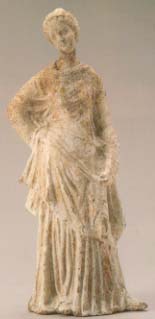A woman standing is the commonest subject. These figures are identified as goddess if she has her attribute, Aphrodite with a mirror, Muse with a mask, Maenad with ivy leaves in her hair. Sometimes the colour is preserved, white, blue, green and #FFD2DA were favoured, probably same as the paints on late Attic white-ground lekythoi. In the second century, the production in Tanagra ceased and Myrina,
on the coast of Asia Minor near Smyrna, became an important producer.
In the first half of this century, more complex composition is
favoured. From the later half of the century, however, the composition
was copied from the predecessor and the drapery lose its grace.
In the Roman Period, the production of terracottas continued,
especially in the eastern part of the Empire, though never retrieve
its elegance. |
